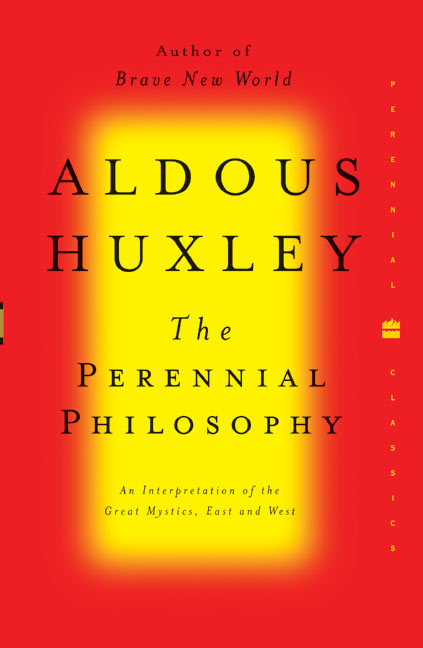One of Frye’s primary sources for mystical texts was Huxley’s The Perennial Philosophy, where he found his “oft-thought good ideas well-expressed as well as [his] bad ones” (CW 13, 24). The philosophia perennis, a phrase popularized by Leibnitz, was for Huxley the timeless and universal ground of all Being––what he calls “the divine Reality.” Metaphysically, the divine Reality underlies everything in the world, including human minds. Psychologically, it is the same thing as the soul. Ethically, the ultimate end of the human enterprise is to be found in the immanent and transcendent ground of Being. Huxley proposes that this ground of Being in all religions is one and the same and that it constitutes the essential core of each religion. His book, which Frye read shortly after it was published in 1945 (New York: Harper), is an anthology of selections from the tradition of the philosophia perennis, sandwiched between Huxley’s commentary. What follows are Frye’s notebook entries that refer to the perennial philosophy. For an account of Frye’s reading of Huxley, see Northrop Frye: Religious Visionary and Architect of the Spiritual World, pp. 176–80.
Thus, without losing its specific historical orientation through Judaism and Christianity, the Bible is an archetypal model of a perennial philosophy or everlasting gospel. At least, that’s what I’d call it if I were writing a book on religion. We really do move from creation to recreation. (CW 5, 28)
I have an old note about eros and logos, creation by desire and creation by the Word. It may be linked with another which quotes Huxley’s Perennial Philosophy as saying that the soul is female and the spirit male. Note that the new heaven and the new earth is the real Tao, yang & yin in perfect balance. (CW 5, 10)
Wisdom in the Bible is an outgrowth of Torah, instruction, the completion of the knowledge of good and evil in its genuine form. Biblical wisdom is not just wisdom, not the wisdom of Egypt or Sumeria, any more than its Yahweh is Ptah or Enki. It has affinities, of course, but not to the point of blurring its identity. That’s why Hebrew wisdom develops dialectically into prophecy, which again is Biblical prophecy, not Zoroaster or Tiresias prophecy. All religions are one, not alike: a metaphorical unity of different things, not a bundle of similarities. In that sense there is no “perennial philosophy”: that’s a collection, at best, of denatured techniques of concentration. As doctrine, it’s platitude: moral maxims that have no application. What there is, luckily, is a perennial struggle. (CW 5, 110)
In the third lecture I want to proceed from the gospel to the Everlasting Gospel, and yet without going in the theosophic direction of reconciliation or smile-of-a-fool harmony. The synoptics make Jesus distinguish himself from the Father, as not yet more than a prophet: it’s in the “spiritual” gospel of John that he proclaims his own divinity. (That’s approximately true, though one has to fuss and fuddle in writing it out.) Yet John is more specifically and pointedly “Christian” than the synoptics: the direction is from one spokesman of the perennial philosophy and a unique incarnation starting a unique event. Buddhism and the like interpenetrate with the Everlasting Gospel: they are to be reconciled with it. I don’t quite yet know what I mean. (CW 6, 618–19)
Huxley’s Perennial Philosophy is a book I must keep in touch with: my point about the soul as female & the spirit as male (p. 174) is there in full force. (CW 13, 360)
The second stage is the mind’s withdrawal from creation into the death-consciousness of contemplation and observation. God here becomes a first cause and (as in St. Thomas) a clearing-house of absolute terms—essence, being omni- this and that. Here everything is focussed on the judgement that accompanies death, which in turn is the inevitable consequence of an act of creation, a making of the world. As it proceeds, its one God becomes less personal, & the stage ends in “Thou art That” mysticism, the so-called perennial philosophy. It starts with a personal Creator & ends in a “hid divinity,” a God beyond God. (CW 13, 100)
The third, as I now see, is an essay on the typology of the Bible leading up to the question of what comparative religion compares, or, what does religion as a whole say, when considered, not as religio or social observance, or as symbolism, which doesn’t say anything, but as doctrine, in the sense of an imaginative vision which is also existential and committed? I don’t believe in a “perennial philosophy,” but there is something here. (CW 13, 110)
